Ryan Hall's Blog, page 319
November 20, 2015
Washington’s National Zoo Cutting Hours Because of Runners and Walkers

Photo: Shutterstock.com
The Washington Post has an interesting piece about the National Zoo—one of the most popular zoos in the U.S.—which is cutting hours in 2016.
The reason? Safety. According to the Post, the zoo has a 2.5-mile trail that is popular with runners and walkers, and those people “tend to collide with the many vehicles that bustle around the zoo ferrying food, keepers and veterinarians to the animals, especially when it’s not quite light out in the early hours of the morning.”
As a result, the zoo will now open at 8 a.m. instead of 6 a.m., which will undoubtedly force morning runners and walkers to find somewhere else to go before work. The zoo will also close one hour earlier at night. Some indoor exhibits at the zoo will open earlier as a trade-off.
RELATED: 5 Places to Run In…Washington D.C.
“We’ve had for some time, going back years, increasing concern about safety and security,” zoo director Dennis Kelly told the Post. “We’ve observed many near misses for walkers and joggers, particularly in the dark. We’ve had joggers with headphones bumping into parked vehicles.”
He added, “I’m just not going to wait and have a tragedy here.”
MORE: Washington Post
The post Washington’s National Zoo Cutting Hours Because of Runners and Walkers appeared first on Competitor.com.
160 Pounds Lighter, Man Runs Third Marathon in Las Vegas
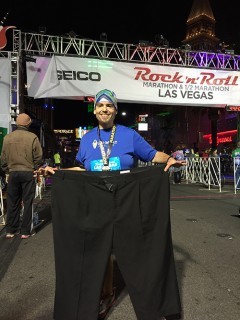
At the finish line, Kris Wright holds up the pants he wore more than two years ago when he weighed 330 pounds.
Steps from the finish line at the GEICO Rock ‘n’ Roll Las Vegas Marathon on Nov. 15, Kris Wright was handed the black, 60-inch waist pants he wore two and a half years ago. He weighed more than 330 pounds then.
“I got bigger than that,” says the 5-foot-6-inch Wright, “But I didn’t want to see that scale anymore.”
Wright used to drive on long-distance trips rather than fly because he hated the stares he would receive on airplanes and inconveniencing anyone sitting next to him. On the street, people would shout, “Hey, fatty!” And when he was still obese and started running, somebody once yelled, “You run like an elephant!”
That was then. Wright, 38, now weighs 166 pounds and was all smiles at the Rock ‘n’ Roll Las Vegas event this past weekend, finishing his third marathon in 4 hours, 25 minutes and 40 seconds.
PHOTOS: 2015 Rock ‘n’ Roll Las Vegas Marathon and 1/2
“Holding the pants at full width, I thought about how far I’ve come,” says Wright, an accountant living in Oklahoma City. “To think where I’ve come, it’s amazing.”
Wright’s epiphany about losing weight and changing his life came Feb. 3, 2013 when he was talking with coworkers about when he was younger and enjoyed hiking.
“As I was talking to him [his coworker], something clicked in my head,” Wright recalls. “I was making excuses. I had plenty of time [to work out]. I had no reason not to.”
He told a coworker he was heading to the gym the next day. The friend promised to text Wright the next morning, holding him accountable. When Wright received the text, he was already at the gym. To this day, he still has the text saved on his phone.
Wright committed going to the gym twice a week. A month later he added a third day. A month after that he changed his diet. “I switched from a very healthy diet of pizza, donuts and cheeseburgers every day to eating a lot more vegetables and grilled chicken,” he jokes.
Being heckled about his weight when he first started running didn’t bother Wright because he had already made a mental transformation.
“I no longer felt like the person they were shouting at,” he says. “I thought of myself as the person I would become.”
A year after resolving to turn his life around, he weighed 200 pounds. In October 2014, 20 months after weighing at least 330 pounds, he ran his first marathon. He ran another in April of this year, clocking a 4:04 PR.
Next on his 2016 racing calendar: his second 50K ultra, a 50-miler and another marathon.
“It’s a good escape. I get kind of lost with my thoughts,” says Wright of running’s lure. “I feel like I solve all the world’s problems when I’m running. Of course, when I’m finished, I forget everything I solved.”
The GEICO Rock ‘n’ Roll Las Vegas Marathon was Wright’s first Sin City run, and he thoroughly enjoyed the experience.
VIDEO: Relive the Magic of Rock ‘n’ Roll Las Vegas
“It was fantastic, it was awesome, ” he says. “Just running down The Strip (at night), all the lights, all the buildings, all the people, all the bands, it was unlike any other race I’ve ever done.”
The post 160 Pounds Lighter, Man Runs Third Marathon in Las Vegas appeared first on Competitor.com.
Bernard Lagat Plans to Focus on Road Racing After 2016 Olympics
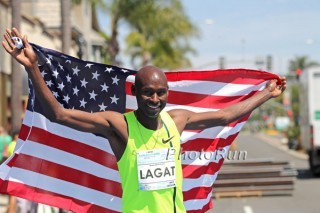
Bernard Lagat set a masters world record for 5K road racing in Carlsbad earlier this year, finishing third in 13:40. Photo: PhotoRun.net
The Washington Post is reporting that the ageless Bernard Lagat will be shooting for his fifth Olympic track team in 2016. Should he make it, he plans on the Rio Olympics being his last championship track meet.
Lagat, who turns 41 in December, represented his native Kenya in the 2000 and 2004 Olympics, medaling in the 1,500m at each one. Lagat became a U.S. citizen in 2004, and represented the U.S. in the 2008 and 2012 Olympics in the 1,500m and 5,000m.
He has already had plenty of success on the roads, too. He’s set over-40 records in both the 5K (13:40 at the Carlsbad 5000 in March) and the 10K (27:48 at the Great Manchester Run) already this year.
As for where his road racing future will take him, he told the Washington Post he’s not exactly sure.
“For the future, I don’t know really,” he told the Post. “I do enjoy the 5,000 meters, 3,000 meters. So for me, if I was to step up and do something else, I think I might feel it might be out of my reach, but I would not say anything is out of my reach. … I think sometimes, mentally I feel like, ‘Man, I cannot do this.’ But when I step into a race itself, I surprise myself. So moving up, moving up and maybe going into half marathons and run a marathon in the future. It might not be competitively, but I can say, ‘Hey, I’ve done a marathon.’”
MORE: The Washington Post
The post Bernard Lagat Plans to Focus on Road Racing After 2016 Olympics appeared first on Competitor.com.
An Open Letter to Sebastian Coe: Invoke Lifetime Bans for Dopers
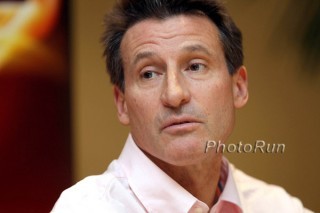
When Sebastian Coe took over as president of the IAAF in August, he said one of his primary objectives was to clean up the sport of track and field and competitive running. Photo: PhotoRun.net
Dear Lord Sebastian Coe, President of the IAAF:
I was an impressionable young teenager runner when I met you and your father at the Kinney Cross Country Midwest Regional Championship (now known as Foot Locker) in suburban Chicago way back in 1983. Although it was a low point of your career, I was in awe of you as an athlete. I got your autograph—the only one I have ever gotten from a professional athlete—and still have it.
The following summer, some of my teammates piled in a car and drove to rival York High School to catch a glimpse of you training relentlessly one humid morning as you went through some of your final preparations for the 1984 Olympics in Los Angeles. Your determination to repeat as the gold medalist in the 1,500 that year—especially in defiance of the doubting British press—and your enduring greatness certainly fueled my own middle-distance running pursuits for a while and had a lasting impact on me.
Like you, I loved running because it made me feel free and pure. Like you, I still love to run and and support the sport, but we both learned long ago that at the highest levels, running isn’t all that pure. Now that you’re president of the IAAF, I’m respectfully counting on you to call upon the integrity and tenacity you carried so proudly as an athlete to boldly and relentlessly clean up the sport. You’ve got plenty on your plate heading into 2016, but I would start by invoking lifetime bans for dopers as soon as you can.
Ensure Better Testing and Invoke Lifetime Bans
The most clear-cut way to clean up the sport and reduce the threat of doping is to invoke lifetime bans for all first-time offenders after due process finds them guilty of performance-enhancing drug use. If it were up to me, I would do it immediately and retrospectively, ridding the sport of all known dopers in one fell swoop. Boom. Good-bye and good riddance.
I know this will be easy to shrug off as a naïve suggestion and impossible to execute, but don’t do that. Remember when you were an athlete how sick it made you to know your competitors were doping? It should be a no-brainer and plenty of athletes agree, including Alysia Montaño and Molly Huddle. Use your power to make it happen. Start with the notion that doping is a problem that’s crippling the sport and work your way down from there.
Honestly, if you had a moldy piece of spoiled fruit in the bowl on your kitchen counter, would you put it in the trash or compost bin? Or would you keep it with the rest of your fresh fruits and vegetables? How should an aspiring young runner feel if you keep the bad fruit around to spoil everything?
Let’s face it, there will always be athletes who try to cheat. But the incentive to do so will be considerably reduced if the imminent threat of lifetime expulsion, elimination of sponsorships, punitive financial penalties and permanent humiliation are known punishment. I’m not talking about jail time. I’m just saying make those cheaters go away.
Instead, we have an athlete like two-time offender Justin Gatlin, who is somehow able to talk his way out of a lifetime ban in 2006 only to return to action four years later and take national team spots and sponsorship dollars that could have gone to clean athletes. He’s just one example (albeit one of the worst) that plagues our sport.
If you want fans, sponsors, media and aspiring young athletes to stick with the sport and believe in the amazing athletic performances they see, take a stand and immediately exterminate the sport of athletes and coaches like, along with others, Gatlin, Tyson Gay, Jon Drummond, LaShawn Merritt, Trevor Graham, Mary Akor Basley, Rita Jeptoo, Asli Cakir Alptekin, Liliya Shobukhova, Mo Trafeh, Marion Jones and Ben Johnson—among the many people we have watched win medals, break records and become celebrated personalities of our sport despite hovering suspicions about their integrity or, worse yet, a record of blatant cheating.
Say what you want about the expulsion of Pete Rose from baseball, but the lifetime ban he was given in 1989 certainly removed the corupt cloud of gambling he brought to the game. Just think if baseball had done the same with dopers in the late 1990s. (Sadly, Major League Baseball couldn’t even rid itself of the problem after it knew who the dopers were—largely because of the player’s union—but at least it started to crack down.)
While I understand there are plenty of legal and reasonable therapeutic use exemptions that can raise a red flag on a drug test, the current drug-testing protocol is entirely too soft. It’s too easy to beat the tests and most athletes aren’t tested often enough. The World Anti-Doping Agency announced this week it will “put greater focus on strengthening compliance work so that all anti-doping organizations worldwide are held accountable to deliver robust anti-doping programs” but improving testing science and insuring every federation in the world is dedicated to diligently testing its athletes can’t happen soon enough. You should up the ante and tell the world that IAAF is now banning first-time offenders with lifetime bans.
When it comes down to it, the biggest problem is that the penalty for first-time doping convictions is entirely too soft. In most cases, an athlete will get banned for two years and then have a chance to come back before the next Olympic cycle. (And there is belief those athletes still might benefit, even if they do come back clean.)
“The slaps on the wrist that some of our own athletes have received is a disgrace,” says Montaño, a six-time U.S. 800-meter champion who finished fifth in the 800-meter run at the 2012 Olympics. “They’ve been popped for doping, they help out and give up some information and they’re allowed to come back? No, that shouldn’t be how it works. Get out! If they’ve been busted, get them out of the sport because they’re making us all look bad.”
Despite knowingly having been beaten by dopers in her career—and Seb, you know know as well as anyone that the clean athletes always know who the suspected dopers are—Montaño has kept her chin up and remained motivated to train hard in the pursuit of greatness. But at last year’s IAAF World Championships in Beijing—the eighth international championship meet of her career—she found herself entirely discouraged watching ex-dopers compete for—and win—medals.
Most notably, American sprinters Gatlin, Gay and Mike Rodgers, despite a combined four convictions that could have resulted in a cumulative 15 years of suspensions, all made the finals of the 100-meter dash and finished 2nd, 5th and 6th. (Several of those suspensions were appealed and reduced.)
“In the 100-meter race, it was impossible for me to cheer for my own teammates,” Montaño says. “How sad is that? It’s an insult to me as an athlete.”
Allowing convicted dopers to return not only allows those cheaters to make more money, but it also allows those dopers to take Olympic berths and endorsement deals away from clean athletes and ultimately puts a cloud over the current generation of clean stars. It also thwarts young up-and-coming athletes from making it at all. (And Justin Gatlin just stop it. Stop telling the world that you won’t talk to the press because they’re still calling you a doper.)
There’s nothing the IAAF, IOC or USATF can or will do for someone like Montaño, even if she is retrospectively awarded the bronze medal for the 800 meters at the 2012 Olympics. She was fifth in the race, but the runners who finished first and third in that event were dopers from Russia. Even if she gets the medal she justly deserves, she’s forever lost out on money, moments and glory that can never be replaced. What kind of message does that send to the clean athletes in our sport? What does that say to teenagers getting started in the sport? What does it say about our sport’s leadership?
“She’s had millions of dollars stolen from her and she’s still out here grinding away on the track and doing it the right way,” says two-time U.S. Olympic 800-meter runner Nick Symmonds, a silver medalist in the 2013 IAAF World Championships in Moscow. “It’s really sad when you think about how many people who aren’t doing it on the level and ruining it for those who are. It’s hard to even think about.
“I believe in Seb Coe. I believe he wants what is best for the sport. He’s a former athlete and I think we all have to give him a chance to clean it up. But I almost think you have to burn it to the ground and start fresh.”
RELATED: 7 Things Track and Field Can Learn from Cycling
Take a Much Bolder Stand Against Dopers
When you took your new job as IAAF president last summer, it was clear the biggest task at hand was to clean up the sport. Yes, most athletes are clean, but the sport has been sullied with dopers for years and the IAAF hasn’t done nearly enough to eradicate it. There have been hundreds of doping suspensions over the past decade and we all know there are dozens more medal winners who have gotten by without ever being busted or, worse yet, allowed to come back too easy with reduced penalties.
While the first step of cracking down on Russia was a nice and obvious gesture, it’s certainly disappointing to know that the IAAF (for which you have served in a leadership role since 2007) has been complicit in the cover-up at some level for far too long. And already, it sounds like Russia, which received a very vague “provisional suspension” could get off lightly and be allowed to compete in the Rio Olympics.
Please take a stand—and set a tone for things to come—by using your influence to keep Russia out of Rio. Merely keeping them out of the 2016 IAAF Indoor World Championships would be completely meaningless and it would show you’re more about lip service and not committed to cleaning up the sport or the dirty politics of the IAAF.
But you also have to admit it’s not just Russia that’s a problem right now. Where there is smoke there is fire, and there has been a lot of smoldering around the globe for decades—most recently in the U.S., Kenya, Morocco, Jamaica and right under your nose at the 2012 London Olympics, which some people have called the dirtiest Olympics in history. Put everyone on notice—athletes, coaches, agents, federations, sponsors—that you’re serious about cleaning up the sport.
If not, your own credibility will continue to be called into question and you’ll soon be looked at as another crooked administrator who chooses not to act.
“It’s hard to have believe in Seb Coe honestly not knowing what was going on and have belief in him being able to clean up the current problems,” Montaño says. “I think he’s part of the problem, and I think the whole house needs to be cleaned up.”
Sincerely,
Brian Metzler
Editor-in-Chief,
Competitor magazine
Competitor.com
The post An Open Letter to Sebastian Coe: Invoke Lifetime Bans for Dopers appeared first on Competitor.com.
Running Form Drill: Bounding
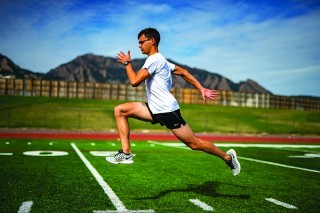
Photo: James Carney
WhyBounding helps strengthen all the muscles in your lower legs while also improving power and stability.
When
Bounding is a great early-season drill and should be included as part of a comprehensive drill routine following one to two easy runs a week.
How
Exaggerating the running stride, launch yourself forward off your left leg, driving your right knee up to waist level while keeping your back (left) leg straight. Aim for one second of “hang time” before landing softly on the ball of your right foot. When your foot hits the ground, launch yourself forward again in the same manner. The arm opposite your lead leg should swing forward for added momentum. Do two 30-meter reps, progressing to 50-meter reps as you build strength and coordination. For added variety and a greater challenge, do this drill on a gradual incline.
RELATED:
—Lateral Bounding as a Dynamic Warm-Up
—The Runner’s Guide to Bounding
—Running Form Drill: Straight-Leg Runs
The post Running Form Drill: Bounding appeared first on Competitor.com.
3 Foam Rolling Exercises for the Injury-Prone Runner

“Most runners who deal with IT band syndrome and tight leg muscles typically also have hip weakness, specifically in their glutes,” says Jason Hantavis, MSPT, CSCS, OCS. “Complementing foam rolling with hip abduction and glute-strengthening exercises will assist in rehabilitating an injury, or preventing one in the future.”
RELATED: 6 Exercises to Work Your Glutes
Photos by: James Carney
Photo Gallery
1 of {count}
Back to Start
View Larger Image

Quads
Get on your stomach and place your thighs atop the roller, supporting your upper body with the elbows. “Use your arms to pull and push your body, moving the roller from your upper thighs down toward the knees,” Hantavis says. “Be careful not to roll over your kneecaps.”
View Larger Image

Hip
Place the outside of your thigh on the foam roller, using your arms and the other leg for support. “Roll up and down the side of your leg from your hip to your knee, but do not go up too far and roll over your hip bone,” Hantavis says. Roll for 2 minutes before switching sides.
View Larger Image

Hamstrings
Sit on the roller and, using your arms for balance behind you, work the roller up and down from the base of your butt to the back of the knees. Spend 2 minutes rolling on each leg.

More Galleries
The post 3 Foam Rolling Exercises for the Injury-Prone Runner appeared first on Competitor.com.
Trail of the Week: Topanga Canyon, Southern California

Our Trail of the Week feature is made possible through a partnership with Trail Run Project.
The Backbone Trail is one of the most popular trails in Southern California. It’s total length exceeds 65 miles, extending from Point Mugu State Park to Will Rogers State Park near Santa Monica. This Topanga Canyon loop explores, among other paths, the eastern part of the Backbone Trail and offers spectacular views of downtown Los Angeles, the Pacific Ocean, the San Fernando Valley and more.
From Will Rogers State Park, take the Inspiration Point Loop trail. After about half a mile of dirt trail you’ll see the sign for the Backbone Trail.
The Backbone Trail has a lot of loose rock, single-lane trail in the first section. The first junction will come up around 2 mile mark, stay left (West) and continue on Backbone Trail. This is a scenic section with views of Santa Monica behind you. Be careful of tree roots and loose dirt on the trail. It is a good time to spot deer and foxes during a morning run.
At the 6-mile mark there will be a sign pointed to “The Hub”, take the left route to continue down Backbone Trail. Keep staying right and The Hub will be in view at the 7-mile mark. A restroom is available there but no water. It’s also time to admire the view of Santa Monica to the south, and the San Fernando Valley to the north.
The most challenging part of this loop is at mile 18, an 800-foot climb in one mile. Be careful for mountain bikers speeding down. Once you climb this hill, you’re almost done!
The Data
Miles: 20.6
Runnable: 89 percent
Average Grade: 6 percent
Max Grade: 33 percent
Total Ascent: 3,258 feet
Total Descent: -3,260 feet
Highest Elevation: 2,071 feet
For a closer look, check out the interactive map, data, photos and virtual run simulator courtesy of Trail Run Project:
The post Trail of the Week: Topanga Canyon, Southern California appeared first on Competitor.com.
November 19, 2015
A New Kind of Group Run: Treadmill Studios are Growing Fast
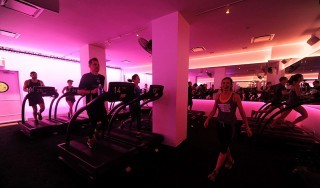
A class at the Mile High Run Club in Manhattan.
Many runners cringe at the thought of doing a treadmill workout alone.
But group speed sessions on treadmills—led by experienced coaches in upscale studios—are quickly gaining followers across the country.
The Mile High Run Club in New York City opened just more than a year ago and already has done nearly 3,000 classes. There has been such demand that some sessions have waiting lists, says owner Debora Warner.
“It’s been a great year,” she says. “A very strong start.”
Group interval training on a treadmill is so appealing because runners benefit from the class atmosphere without the worry of being too fast or slow for the pack, she says.
Combine that with enthusiastic coaches, high-energy music and glowing lights, and runners are hooked.
“If someone is going to embrace the treadmill as a training tool, then why not make it the best it can be?” Warner says.
RELATED: How to Make the Most of Treadmill Training
The studio is doing so well Warner plans to open a second location with 35 treadmills in the coming months. Mile High will take over the 3,300 square-foot space in Manhattan where TheRUN, a competing treadmill studio, operated until recently.
The success of Mile High has sparked new businesses outside of New York.
MyStryde is scheduled to open on Hanover Street in Boston early next year, says founder Rebecca Skudder, 27.
Skudder says the Northeast’s brutal winters gave her the idea several years ago, but she wasn’t prepared to start her own business then.
“I was training for a half marathon in the winter,” she says. “I especially remember getting on the treadmill, and I had a seven-mile tempo. I thought, ‘I can’t do this.’”
Since then, she wondered whether treadmill gyms could catch on like indoor cycling studios. The success of Mile High has convinced her they can.
“Once we saw Mile High open up, I said, ‘Yes, it’s right. If we don’t open now, someone else will,’” she says. “It proved that the idea was A. doable and B. popular—people were into it.”
MyStryde will have a dozen treadmills, including one for the instructor, and offer speed and incline interval classes, ranging from speed walking to marathon training. Workouts will take 45 minutes to an hour and 15 minutes.
For example, one class will include a 5-minute warmup followed by a 30-second hard effort at your 10K race pace and 30 seconds of recovery. The next hard interval includes a 1-percent incline and a .3 increase in speed. The hard intervals increase to 60 seconds as the speed and incline are also pumped up.
Set to upbeat music and taught by running coaches, the classes will be both fun and challenging, Skudder says.
“It’s something I always wanted to do, and it’s something that means a lot to me,” she says. “Hopefully it’s the right time, and Boston is the right city.”
Indoor running classes are also picking up speed on the West Coast.
Samantha Hubshman, 30, used to dread the treadmill until she started taking running classes at Equinox in West Hollywood. There she met David Siik, who was developing Precision Running, a treadmill program that Equinox launched last year in dozens of clubs across the country.
“Physically you get a workout, but mentally it keeps you totally engaged,’ she says. “I say to myself, ‘Sam, you can do anything for 60 seconds.’ Having it interval-based keeps you engaged in a whole new way.”
Now living in New York City, Hubshman goes to Precision Running classes on the Upper East Side several times a week.
“It transformed my life, and the way I see working out. It’s something I love to do, not something I have to do,” she says.
Siik’s program takes a low key, meditative-like approach to treadmill running.
“It’s not just about the experience, but also the actual effectiveness of it,” says Siik, 35, the national manager of the program for Equinox. “We don’t use music in the class, which surprises people. If you are distracted by music, you won’t be as connected to the flow of the class.”
The sessions follow certain speed and incline patterns to create a balanced workout, he explains.
In one advanced workout, called Fire and Ice, runners alternate between 60- and 30-second hard efforts, with variations in incline and speed, and take 60 seconds of recovery.
The interval changes are complex, but “they are designed to be very mathematical and extremely meaningful,” he says.
Siik, author of “The Ultimate Treadmill Workout,” due to be released next month, says the rise of treadmill classes and dedicated studios is a sign that people want simplicity.
“People get confused and lost in their fitness—they don’t know what is right, and what is wrong,” he says. “Running is having a resurgence. People are hungry for it. They are hungry to get back to what works. Indoor running creates a safe place.”
RELATED: The Tricky Art of Treadmill Pacing
The post A New Kind of Group Run: Treadmill Studios are Growing Fast appeared first on Competitor.com.
2016 U.S. Olympic Trials Marathon Course Finalized
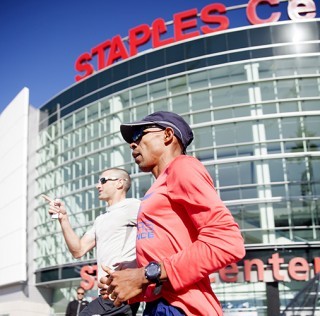
Meb Keflezighi running in front of the Staples Center along the Trials course.
The 2016 U.S. Olympic Trials Marathon course was finalized this week, and it will take Olympic hopefuls through both downtown Los Angeles and parts of South Los Angeles—passing by the Los Angeles Memorial Coliseum, Staples Center and more. The Olympic Trials Marathon will take place Feb. 13, with the top three men and top three women earning the chance to run for the U.S. at the Rio de Janeiro Olympics. The Trials will have $600,000 in prize money up for grabs.
The Los Angeles Marathon and USA Track & Field announced Thursday that the U.S. Olympic Trials course has been completed. Similar to the courses created for the Olympic Trials races in 2008 (Boston/New York) and 2012 (Houston), the criterium-style course in Los Angeles is mostly flat, and was set up to be fan-friendly, as spectators will be able to see runners pass several times from wherever they set up.
The race will start near Staples Center on the west side of downtown Los Angeles, and racers will go on one 2.2-mile loop north of the start line into the heart of downtown, turning around at roughly 6th and Flower. Racers will then run back toward the start line and start the first of four 6-mile loops that travel into South Los Angeles down Figueroa Street. The course will take runners through the campus of the University of Southern California and pass by Exposition Park and the LA Coliseum—where Joan Benoit Samuelson finished up her gold medal marathon at the 1984 Olympics.
The race will finish where it started near Staples Center and the LA Convention Center. While the course has a lot of turns, mostly around the LA Coliseum, there aren’t any significant hills—which could net some fast times.
View a close-up of the course map here.
RELATED: Excitement Mounts as Olympic Trials Marathon Fast Approaches
The post 2016 U.S. Olympic Trials Marathon Course Finalized appeared first on Competitor.com.
New Balance Launching 3D-Printed Running Shoe in Boston in 2016
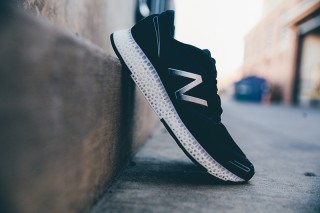
New Balance will unveil this yet-unnamed shoe with a 3D-printed midsole in early 2016.
New Balance has announced plans to launch a new state-of-the-art running shoe in April that incorporates a 3D printed midsole. While other brands have also been developing 3D printing for footwear, the yet-unnamed New Balance shoe could become the first of its kind available to recreational runners.
New Balance says the new midsoles will leverage the benefits of 3D printing and breakthroughs in materials science “to achieve an optimal balance of flexibility, strength, weight and durability.” The price and sample size weight specs of the new shoe haven’t been made available as of yet, but the shoe will have a 6mm heel-toe offset. The new high-performance shoes will have midsoles made from a newly developed elastometric powder and a process known as selective laser sintering (SLS). That process involves converting the DuraForm Flex TPU powder materials into solid cross-sections, layer by layer, using a laser.
VIDEO: Watch a New Balance Video Explaining Its 3D Printed Shoe
New Balance, a privately owned Boston-based company, says the latest designs of the 3D printed midsole are based on underfoot pressure data from heel strikers with more cushioning elements in areas of higher average pressure. This data-to-design formula is similar to the protocol New Balance designers used to create the award-winning Fresh Foam collection.
RELATED: An Up-Close Look at the New Balance Fresh Foam Zante
New Balance will debut the limited edition shoes at 2016 Consumer Electronics Show Jan. 6-9 in Las Vegas, but they won’t become available to the public until April in Boston. (The company hasn’t said whether the shoes would be available at the 2016 Boston Marathon race expo or at the New Balance store on Boylston Street near the Boston Marathon finish line.)
“This project represents an unprecedented technical collaboration in footwear,” New Balance senior manager of innovation and engineering Sean Murphy said in a release. “To deliver this level of performance with a 3D printed component, we paired experts in running and biomechanics with leaders in plastics engineering, material development and generative design. These are the types of collaborations that will drive footwear design and manufacturing in the future.”
Several other brands are also working on 3D printed footwear concepts, but this is the first announcement of a shoe that will be available to consumers.
New Balance has been developing its 3D printed footwear technologies for several years. In 2013, it developed track spikes for middle-distance runner Jack Bolas with a data-customized, 3D-printed spike plate, the first time the technology has been used in competition. Last year, Kim Conley won the 10,000-meter run at the U.S. championships in a pair of custom-printed spikes. The brand has also used the technology to create customized footwear for baseball and soccer players.
RELATED: How New Balance Developed the 1500v2 for Ironman Champ Sebastian Kienle
“In 2013 we said this was the future of footwear manufacturing and today we are proud to bring the future to consumers with a fully 3D printed midsole,” said New Balance president and CEO Robert DeMartini. “With 3D printing, we are able to pursue performance customization at a whole new level.”
Related: Adidas Uses 3D Printing to Develop Customizable Shoes
The post New Balance Launching 3D-Printed Running Shoe in Boston in 2016 appeared first on Competitor.com.
Ryan Hall's Blog
- Ryan Hall's profile
- 21 followers



